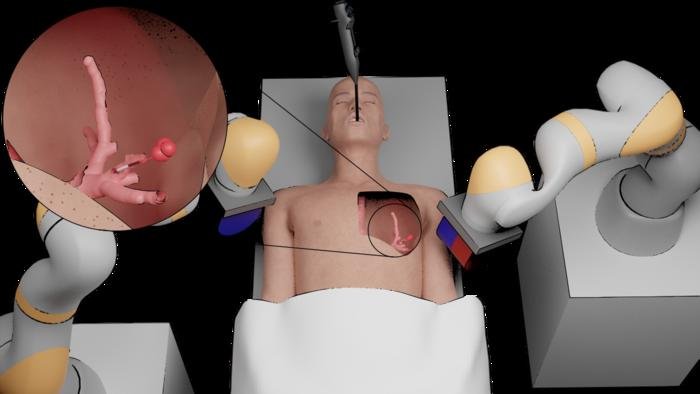Scientists say they have developed fully functional miniature robots that can go deep inside the human body to perform ultra-precise laser surgery, in a medical innovation similar to on-screen portrayals from science fiction.
Controlled by magnetic fields, the tiny wormlike robotic surgeons were recently demonstrated traveling deeper inside a human cadaver’s lungs than is possible with current state-of-the-art surgical instruments. One of the researchers behind the achievement tells The Debrief that there are a number of organs and systems the incredible “micro-bots” can get inside to perform similar pinpoint explorations and surgeries.
Miniature Robots Performing Surgery Has Long Been a Dream of Science Fiction
In some of the more utopian science fiction of the middle 20th century, medicine has advanced to the point that nearly all diseases and ailments have a treatment, if not an outright cure. Some of these futuristic cures involve genetically engineered super drugs, blasts of scientific-sounding rays, or even an injection of alien blood. However, seemingly the most common therapy of the future envisioned by TV writers, movie directors, and novelists involve injecting minuscule robots into the human body and letting them go to work.
Now a team of researchers says they have moved this idea from science fiction to science fact by designing the first pair of tiny surgical roots that can literally go where no surgeon has gone before.
Magnetic Fields, Tiny Cameras and Ultra-Precise Lasers
In an email to The Debrief, Professor Pietro Valdastri, Director of the STORM Lab and research supervisor, said that the robots themselves are made of a biocompatible plastic (silicone) with magnetic particles embedded inside them.
The first part is significant so the human body doesn’t have a negative reaction to the otherwise foreign objects operating inside of the body. However, it is the precision placement of the embedded magnet particles that allow the two wormlike robots to maneuver independently.
“Normally, two magnets placed closely together would attract each other, creating a challenge for the researchers,” the press release announcing the breakthrough procedure explains. “They overcame it by designing the bodies of the tentacles in a way that they can bend only in specific directions and by relocating the north and south poles in each magnetic robot tentacle.”


A pair of magnetic devices operating outside the human body can generate fields strong enough to cause the robots to maneuver deeper inside the lungs than even the most advanced equipment. And by moving independently, one of the robots can carry a camera to assist surgeons, while the second robot can guide a surgical laser with extreme precision.
When asked how a robot that is only 2 millimeters in diameter can carry a laser, Valdastri told The Debrief, “the source of laser is external, but the laser light is sent to the tip of the magnetic tentacle via an optical fiber. So laser energy is delivered at the tip of the tentacle directly on the target.”
In the video released by researchers (below), the pair of miniature robots are seen navigating deep into the lungs of a human cadaver. This is significant, they note, because lung cancer that often requires surgery has the highest mortality rate of any cancer worldwide. Still, when asked by The Debrief if the miniature robots can work in other areas of the body besides the lungs, they said there were a number of biological systems that would accommodate these micro-surgeons perfectly.
“The same approach can be used to reach the deep part of the brain, the pancreas, the bladder, and any other body cavity that is accessible through a narrow lumen,” Valdastri said. “The cardiovascular system is also another potential district of use.”
“Living Tissues” Clinical Trials Are the Next Proving Ground
Now that the robots have been shown to move successfully and independently in a biological environment, the team behind the exciting research effort, which was published in the journal Nature Engineering Communications, says they are working their way toward actual human trials with actual lung cancer patients. However, there is likely one more step along the way.
“For the lung cancer application, (the) next step(s) are trials in a more realistic environment that includes living tissues and respiration, so probably animal model,” Valdastri told The Debrief. “After that, human trials, possibly in 2-3 years from now.”
Given the abilities and functionality of these miniature robots, it seems that one day in the not-too-far distant future, they will actually be in medical facilities around the world exploring and repairing the deepest recesses of the human body like something right out of a movie. Plus, the researchers explain, there is a significant aspect of access for everyone and not just the rich that may make them even more successful
“The key point is that this new magnetic technology can allow us to reach way deeper into the human body than ever before in a way that doesn’t require extremely qualified surgeons (thanks to robotic guidance/assistance),” Valdastri told The Debrief. “We hope this way to democratise cancer treatment and increase access to top quality procedures.”
Christopher Plain is a Science Fiction and Fantasy novelist and Head Science Writer at The Debrief. Follow and connect with him on X, learn about his books at plainfiction.com, or email him directly at christopher@thedebrief.org.

